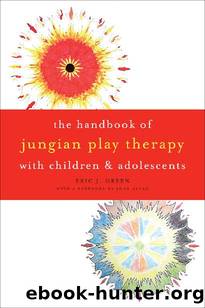The Handbook of Jungian Play Therapy with Children and Adolescents by Eric J. Green

Author:Eric J. Green [Green, Eric J.]
Language: eng
Format: epub
Publisher: JHUP
Published: 2014-10-16T03:00:00+00:00
Jungian Play Therapy Approaches to Promote Secure Attachment
Although attachment relationships are thought to be relatively stable over time (Allan, 1988), they are indeed revisable within the context of new relationships. For many adolescents who enter play therapy, their experiences of empathy have been limited or disrupted in their early relationships (Green, Crenshaw & Langtiw, 2009). Thus, play therapy affords adolescents an opportunity to experience a secure, close relationship with a caring individual in which empathy, nonjudgmentalism, and permissiveness are hallmarks of the therapeutic alliance. Indeed, research has found that the value of the therapeutic relationship is greater than the value of specific interventions utilized in play therapy for youth and improves the quality of future relationships (Green, Crenshaw & Langtiw, 2009).
It is critically important that play therapists demonstrate their dependability early in treatment, through empathic attunement (listening carefully and empathizing accurately within the adolescentsâ phenomenological perspective) and containment of distress with clear boundaries (Reyes et al., 2010). Nichole shared with her therapist that some of the most memorable and successful sessions were those in the first few months, during which the play therapist simply sat with her while she expressed difficult emotions through her artwork and sandplay scenes. She told the play therapist that, over time, she felt less ashamed of her feelings and less afraid that the play therapist would think she was âweakâ or âcrazy.â This view of a secure Self, which manifested itself in her relationships with peers, parents, and siblings, is largely what caused her self-injurious behaviors to desist. It was after she developed trust within the therapeutic relationship that she was able to begin containing her own emotions. During one particularly powerful session, Nichole engaged in an imagery-based containment exercise in which she visualized a safe and secure place where a container with a lock was located. The play therapist utilized guided imagery, accompanied by relaxation music, followed by an artistic exercise in which Nichole would creatively and abstractly paint the emotions felt throughout the imagery exercise. Following this session, Nichole regularly referred to her container and the way she felt safe to open it during her play therapy sessions.
From the beginning of the relationship, play therapists offer insecurely attached clients an opportunity to openly work through difficult feelings of disillusionment and abandonment through the consistency and dependability of the therapist and the therapeutic framework. That is, play therapists demonstrate unconditional congruence, empathy, and predictability in their words and actions. Further, it is the play therapistâs responsibility to regularly explore and resolve anxieties within the transference and the clientâs experience of it. An example of this occurred with Nichole when her play therapist vacationed at the time period that paralleled her high schoolâs final exams. Nichole expressed her resentment about feeling abandoned by the play therapist and her worries that the play therapist might not return from the vacation. Nichole created a sand world where she enacted a symbolic scene with magic stones and fairy princesses similar to what was occurring in her psyche regarding feeling let down that her therapist was vacationing during her finals.
Download
This site does not store any files on its server. We only index and link to content provided by other sites. Please contact the content providers to delete copyright contents if any and email us, we'll remove relevant links or contents immediately.
Bioenergetica by Alexander Lowen(1426)
The Child in You by Stefanie Stahl(1201)
No Bad Parts by Richard C. Schwartz(1171)
Noise: A Flaw in Human Judgment by Sunstein Cass R. & Sibony Olivier & Kahneman Daniel(1155)
The Data Detective by Tim Harford(1101)
Chatter by Ethan Kross(1026)
The Science of Rapid Skill Acquisition by Peter Hollins(870)
The Quantum Psychiatrist: From Zero to Zen Using Evidence-Based Solutions Beyond Medication and Therapy by Biswas Dona(832)
Freedom by Sebastian Junger(813)
The Montessori Baby by Simone Davies(789)
Maps of Meaning: The Architecture of Belief by Jordan B. Peterson(707)
The Science of Self-Learning: How to Teach Yourself Anything, Learn More in Less Time, and Direct Your Own Education (Learning how to Learn Book 1) by Peter Hollins(689)
Evolution Gone Wrong: The Curious Reasons Why Our Bodies Work by Alex Bezzerides(672)
Sadomasochism and the BDSM Community in the United States by Stephen K. Stein(656)
Anxiety For Dummies by Charles H. Elliott & Laura L. Smith(635)
Why Sex Doesn't Matter by Olivia Fane(627)
Disconnected by thomas Kersting(621)
Jung - The Key Ideas: Teach Yourself (TY Philosophy) by Ruth Snowden(595)
The Mechanics of Passions: Brain, Behaviour, and Society by Alain Ehrenberg(592)
